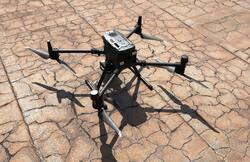
Nippon Steel has been working on making the facility inspection of steel plants more sophisticated through the use of cutting-edge technologies such as drones and IoT sensors. During the week of July 25th, the full-fledged implementation of industrial drones began at East Nippon Works Kashima Area (Kashima, Ibaraki). The drones will be utilized for inspecting the belt conveyors at raw material yards. For the inspection of belt conveyors at Kashima Area, the company installed IoT sensors in April. By remotely controlling the sensors, the company can monitor belt conveyors on a 24 hour basis, and has lead to further improving the precision of inspections.
Kashima Area began operating 7 industrial drones from the end of July. The drones have a normal and infrared camera installed on them, and those cameras are used for inspecting the conditions of belt conveyors. The company states that in the case of inspecting a belt conveyor with a length of 800 m, without drones the inspection work took 2 hours, but now the work has been significantly shortened and only takes 20 minutes.
In April at Kashima Area, around 200 IoT sensors were installed within the belt conveyor system spanning a total of 54 km, including in the drive systems of belt conveyors. The sensors monitor surface temperatures and vibrations on a 24 hour basis, and data is sent once every hour through a wireless communications network. When the company conducted periodic inspections using existing methods, such as visual confirmation by employees, the company had no choice but to accept leaving belt conveyors uninspected for around several days. Now that it has become possible to monitor belt conveyors on a 24 hour basis, the company can continuously monitor the facilities.
As part of their endeavor to implement DX (digital transformation), Nippon Steel is first working on implementing digital technologies for facility maintenance. When some sort of trouble occurs at a given belt conveyor, it affects many production processes. One of the challenges with belt conveyors was that it took a long time to inspect them. In addition to utilizing digital technologies to make the inspections more efficient, the company hopes this will lead to steadier operations.